Two wheels allow herping in areas that four wheels can’t go. Botswana may be landlocked, with an interior comprised mostly of the Kalaha
Two wheels allow herping in areas that four wheels can’t go.
Botswana may be landlocked, with an interior comprised mostly of the Kalahari Desert, but that has not stopped this country from being colonized by more than 150 species of reptiles and countless amphibians. In Botswana, you can find everything from long-tailed thread snakes (Myriopholis longicauda) to different types of tortoises, turtles, Nile crocodiles, and of course, the infamous black mamba (Dendroaspis polylepis).
Read More
Herping for Venomous Snakes in Uganda
5 Great Costa Rican Herping Destinations
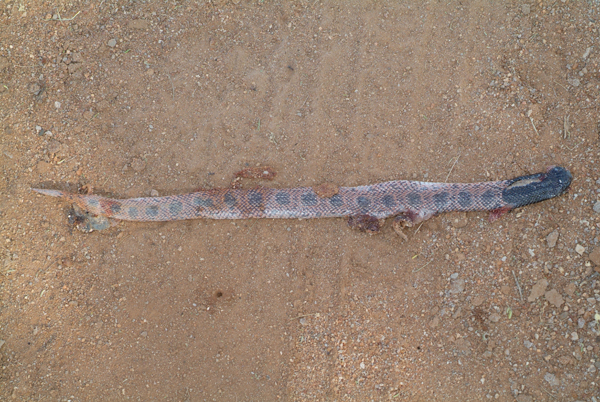
Paul Donovan
Only a few miles into the ride, I came across my first snake—a dead shield-nosed snake (Aspidelaps scutatus).
For the average person living in Botswana, an encounter with any type of reptile is cause to pick up the nearest stick and beat the living daylights out of it. For someone like me, though, who would welcome such encounters, they seldom happen. I have to go looking for them. And so it was, when I decided to pack some camping gear onto my motorbike (a KTM LC4 Adventure that I use to take people on motorbike tours around Botswana) to spend three weeks reptile hunting, just to see what I could find.
Two Encounters: One Sad, One Mad
From my home in Francistown, I would ride toward a village called Nata before veering off along a 154-mile stretch of predominantly sandy track that forms a natural boundary between Botswana and Zimbabwe. As this track has no fencing, game crosses freely from one country to the other, and you can regularly see lion, elephant, rhino, wildebeest, zebra and giraffe.
On either side, the track starts as Lowveld arid savannah with open expanses interspaced with acacia trees and rocky outcrops. As you push further north, it gradually gives way to more lush grassland. During the wet season, this area becomes impassable, as the mud monster will swallow you up.
Only a few miles into the ride, I came across my first snake—a dead one. Someone, presumably a tourist, had driven over it; the track I was traveling was well known to 4×4 drivers who used it as a scenic route up to Kasane, where you can catch the ferry across to Vic Falls.
The dead snake was a shield-nosed snake (Aspidelaps scutatus), the first I had ever seen. It is beyond my comprehension why someone would want to kill a snake, in the middle of absolutely nowhere, that poses a threat to no one. Angrily, I rode on, when my mind was suddenly brought back into check as a banded snouted cobra (Naja a. annulifera, formally the Egyptian cobra, N. haje) slid out of the grass about 30 feet ahead of me.
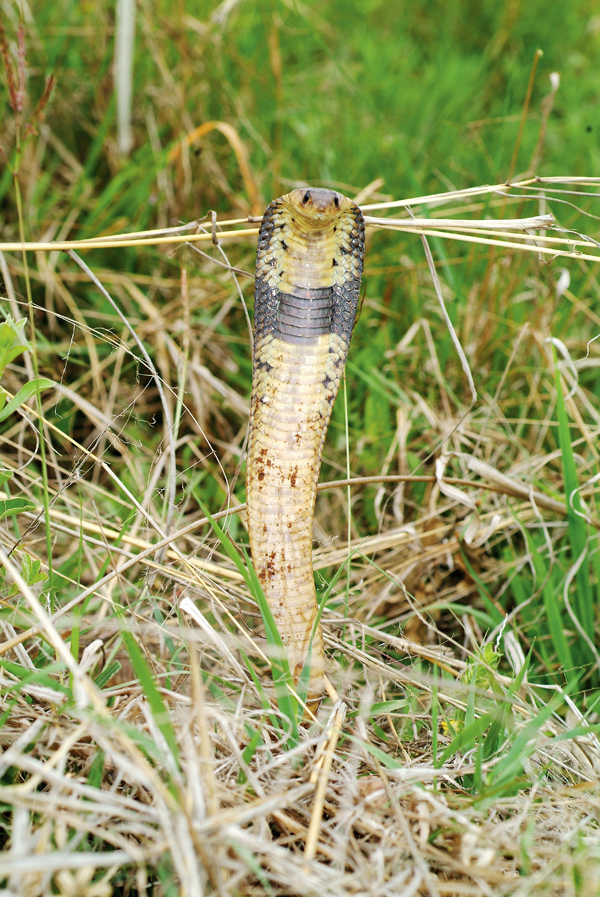
paul donovan
Banded snouted cobra (Naja a. annulifera, formally the Egyptian cobra, N. haje).
I quickly learned the pitfalls of reptile cruising on a motorbike, as I had to stop, flick the bike out of gear, get off, haul the bike onto its kickstand and undo the snake hook from its riggings before going off to find the elusive creature. It was a procedure I would hone to perfection as the days passed; though because much of Botswana is like a giant sandpit, finding somewhere solid to park-up often proved extremely difficult. So I also perfected the art of picking my girl up!
I did catch up with the snake, though, and managed to grab it by the tail. After a bit of huffing and puffing on its part, and persuasive talking on mine, I freed it from the bush into which it had slid. In typical cobra fashion, it showed its resentment by rearing up and staring rather forcefully at me. The nice thing about cobras is that they are easy snakes to photograph; all you have to do is keep their attention. Wave at them with one hand and take the picture with the other. After taking a few photos, I thanked the snake and left it to go about its business.
For the next 25 miles I would stop periodically, do a bit of searching, find nothing, and continue moving on. At one point, I rode straight past a female lion standing beneath a tree. In a moment of total madness I stopped to take a photo, and it dawned on me just how vulnerable I was out there, where I could become the next meal for some flesh-craving carnivore. My vulnerability was demonstrated again a little later on, when a baby elephant suddenly came charging out of the bush right in front of me. That gave me one heck of a wakeup call.
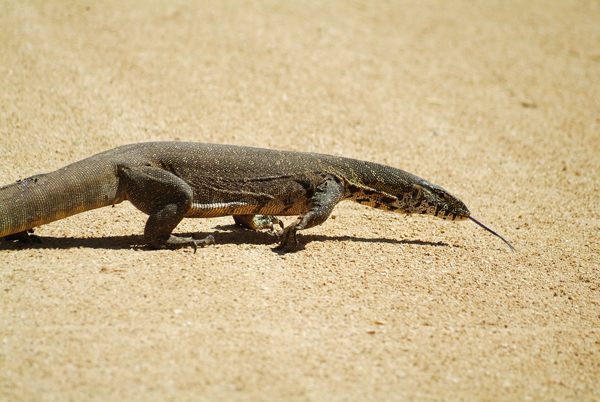
paul donovan
Nile monitor (Varanus niloticus).
A further 9 miles on, I rounded a bend to find a flooded area to my left. Perched on the bank, basking in the sun, was a rather large Nile monitor (Varanus niloticus). I watched it for a good 20 minutes before it decided to head onto the track toward me. You don’t realize how graceful these big lizards are until you see them move with almost serpentine grace, the tongue continually flicking, searching the air for recognizable scents. This one obviously picked up my scent, because it abruptly scampered off into the undergrowth. As time was ticking toward dusk, I decided to pitch camp.
A Familiar Friend
Refreshed and eager to resume my search after breakfast the next morning, I began poking around some nearby rocks. For the first couple of hours there was nothing, other than a lot of backache, but then I spotted a familiar friend, a puff adder (Bitis arietans).
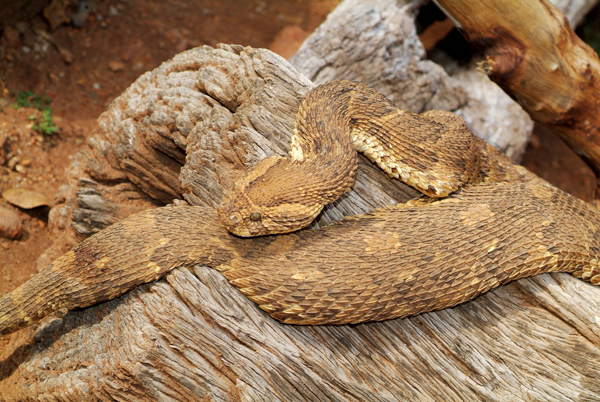
paul donovan
Puff adder (Bitis arietans). The puff adder is responsible for more snakebites in Africa than any other snake.
Considered to be the most dangerous snake in Africa because it accounts for more snakebites than any other species, this individual had wedged itself beneath a rock. By nature, the puff adder is a belligerent ambush predator whose coloration blends so well into the undergrowth that it is easily trodden upon. I remember running into the bush once to answer nature’s call, only to look down just as I was about to do so and spot two puff adders concealed in the grass at my feet. No doubt, they would have taken exception to being peed upon by me. The one I hauled from his hidey-hole was quite placid, probably because it hadn’t yet warmed fully. Still, I wasn’t going to push my luck too much with it, as I was alone, in the middle of nowhere, and certainly didn’t want to get bitten.
Puff adders give the impression of being sluggish, but they actually have the fastest strike of any snake in Africa. From a coiled position, they can strike, inject a huge dose of tissue-destroying cytotoxic venom, and return to their coiled position before you realize you have been bitten. After a few photos I put him back.
Rock Dwellers
As I walked around, I became acutely aware of the continual rustling of leaves. Remembering my earlier lion encounter, every creak and rustle made the hairs on the back of my neck stand proud, and I was just waiting for the moment that “love bite” to the neck would come.
Usually, the rustling I did hear turned out to be nothing more sinister than some variable skinks (Mabuya varia) hunting for their next meal. And where you find lizards, you are bound to come across snakes, and so it was that I chanced upon a western stripe-bellied sand snake (Psammophis s. subtaeniatus).
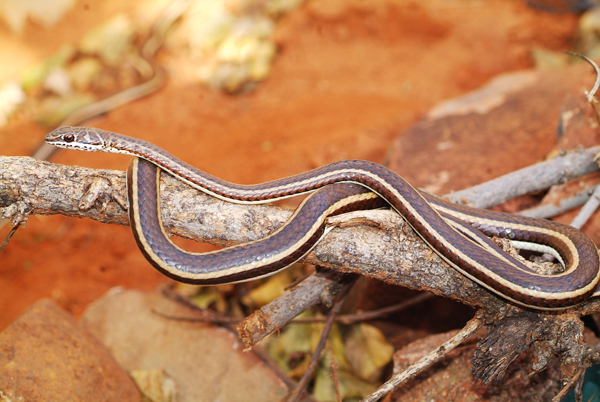
paul donovan
Western stripe-bellied sand snake (Psammophis s. subtaeniatus).
Boy, these are difficult snakes to catch—they are the elite sprinters of the snake world. I lost count of the number of times I rugby-dived trying to catch one, only to come up with a handful of thorny twigs and bloodied knees. But as they say, “perseverance pays off,” and I did eventually come up trumps. The snake responded in typical fashion by latching onto my hand, biting for all its worth, while messing all over me from its other end.
At about 3 feet in length, the western stripe-bellied is one of the largest sand snakes, and arguably one of the prettiest. It is a rich chocolate brown with cream striping and a yellow belly. Toward the neck and head, the solid breaks into blotchy markings.
Although rear fanged, its venom is harmless to humans, but more than capable of subduing the lizards and frogs upon which the western stripe-bellied snake feeds. Although stroppy at first, with a bit of gentle handling the snake calmed down for a few photos.
I spent three days among the rocks searching for reptiles and other creepy crawlies. As I’m sure many of you know, lifting rocks is a hit and miss affair as to whether you find anything. Some days you can spend hours and find nothing more than ants, while other times almost every rock you lift seems to reveal something exciting beneath it. It’s a bit like opening a present, you never know what to expect.
During the three days I spent turning rocks I found three species of scorpion, several species of camel spiders, some colorful centipedes, and countless other insects. One of my best finds was a black-headed centipede eater (Aparallactus capensis). This interesting little snake reaches a length of no more than 12 inches and is restricted to the eastern region of Botswana, where it lives beneath stones and logs, or in abandoned termite mounds. It has a fawn-brown body and distinctive black head, and its diet consists exclusively of centipedes that the snake immobilizes with venom.
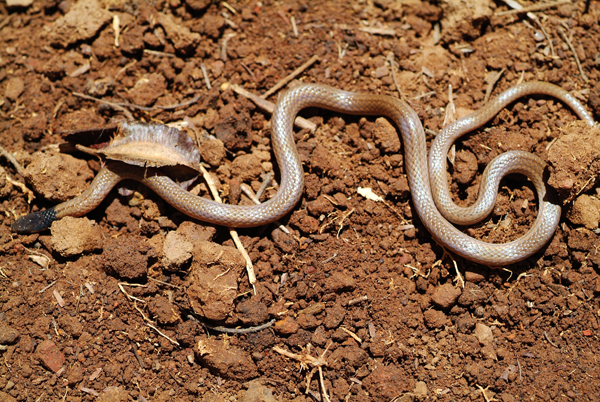
paul donovan
As its name indicates, the black-headed centipede eater preys exclusively upon centipedes, which it immobilizes with venom.
On my last day in the area, as I was packing up, I saw a tail belonging to something crawling beneath my pile of kit. I gingerly grabbed it, expecting to end up with a wriggling lizard’s tail between my fingers, but I had another surprise: it was an eastern bark snake (Hemirhagerrhis nototaenia, also known as the Mopane snake).
Similar in size to the centipede eater, this small, arboreal snake preys on lizards and spends most of its time hidden beneath loose tree bark. Fortunately for me, when handled, the eastern bark snake seldom, if ever, bites.
Dangerous Roads and Cautious Toads
Once packed up, I hopped on the bike and proceeded on my way. Along the track are many game trails that you can take back to the main road, and I decided to head down one of these, when soon, out of the corner of my eye, I spotted a sinuous shape moving quickly across a patch of open ground. It took a few seconds to register what it was, and when I did, my heart skipped a beat. It was a black mamba, and a good-sized one at that. Now, while I’m all for tackling most snakes I come across, taking on a black mamba in the middle of nowhere would have been insanely stupid. I know when to say no! Unfortunately, I didn’t even have time to get my camera out before the mamba was gone.
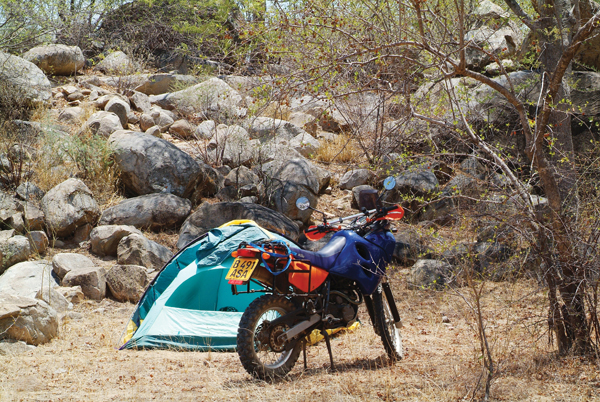
paul donovan
One of the author’s campsites, and the KTM LC4 Adventure motorbike that he was riding.
When I reached the main road, I remembered why I usually avoided riding on this section. Trucks thunder along, heading for the border crossing between Botswana and Zambia like speed demons with little regard for other drivers. They are matched in lunacy by the antics of bus drivers who are forever trying to chase timetables. It’s a dangerous stretch with many accidents.
I was riding toward Tsodilo Hills in the northwestern corner of Botswana. Rather than try to make the journey in one day, I stopped at a campsite on the outskirts of Maun. It did have a crocodile farm on site, another reason for staying there, but it didn’t offer much to write home about.
With tent pitched beneath a tree, I had a shower and something to eat. As darkness descended, a chorus of frogs commenced singing, and I began catching glimpses of movement in the shadows. I turned the flashlight on, and the shadowy figures turned out to be eastern olive toads (Amietophrynus garmani) popping their heads out of the burrows they had dug the night before. A head would appear from the burrow, with two beady eyes that would have a good look around before a cautious little toad would fully emerge. A good 20 or so must have come out that night.
Arrival at Tsodilo Hills
The next morning, about 47 miles outside Maun, I spotted a flap-neck chameleon (Chamaeleo dilepis) crossing the road. Flap necks (or lelobu, as the locals call them) reach a length of about 12 inches. They are steeped in myth and superstition in Botswana, so much so that they are routinely killed on sight. Parking the bike on the side of the road, I decided to help this little fella find a safer place to be. Gaping, it turned as black as the road itself, and repeatedly tried to bite me. So much for repaying the helping hand of a kind Samaritan!
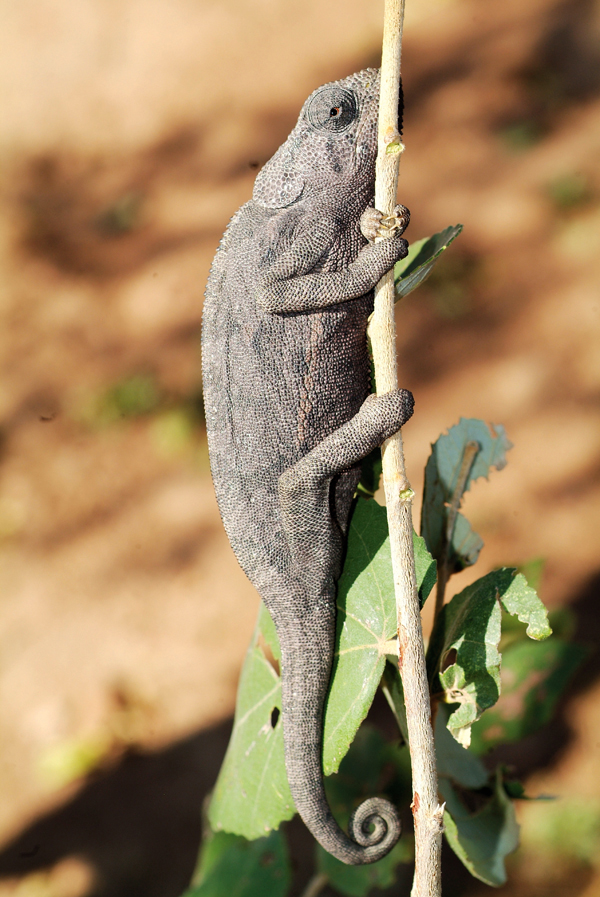
paul donovan
This flap-neck chameleon was unappreciative of the helpful hand the author tried lending it.
Later that afternoon I reached Tsodilo Hills and pitched camp. This is another fantastic place. Although a bit of a trek to get to, it is worth a visit as some of the oldest rock paintings in Africa can be found there. It is also home to the Tsodilo thick-toed gecko (Pachydactylus tsodiloensis), which is found nowhere else on the continent. Unfortunately for me, the geckos had obviously heard I was on my way and had gone on holiday, because I couldn’t find a single one.
The following day, Saturday, was extremely hot. I booked a guide to show me the rock paintings—there are about 4,500 secreted in the hills. She also told me tales of a giant snake that was believed to live in one of the area’s permanent rock pools. Hey, they love their stories out there.
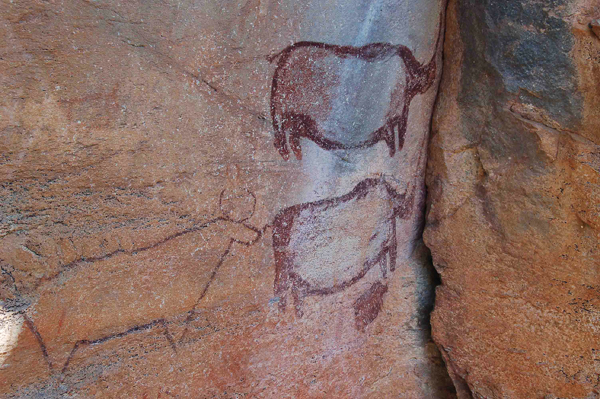
paul donovan
About 4,500 rock drawings—including some of the oldest in Africa—can be found at Tsodilo Hills.
I set off early for a walk in the bush the next morning, and spent the entire day searching for herps, and found nothing. It wasn’t until Wednesday afternoon that I struck gold, when I spotted a boomslang (Dispholidus typus). Another victim of local superstition, people believe that if you walk beneath a tree containing a boomslang, the snake will jump down and bite you. The individual I found was a female, characterized by her brown coloration.
Boomslangs are rear-fanged snakes with large fangs and venom that is as potent as that of many front-fanged species. If you don’t harass them too much they will allow you to get quite close. After taking a few photos, I carried on my way.
Trip's End
I spent another two days at Tsodilo, and although I found no more reptiles or amphibians, butterflies and insects were abundant.
Eventually, I pushed on slowly back home, stopping off here and there, and camping in the bush. For my penultimate night, I camped near a confluence of three river tributaries, although they had about as much water in them as you would use to fill a teacup. Surprisingly, there were quite a few frogs around. My favorite was the banded rubber frog (Phrynomantis bifasciatus), a poisonous species identified by its black and orange coloration.
I’d set myself three weeks for my expedition, and although time slipped past far too quickly, I was amazed at the diversity of species I encountered. Although reptile hunting on a motorbike has its drawbacks, I certainly prefer it over four wheels, as you are granted access to places a 4×4 couldn’t hope to venture into, offering a better way to search the bush. Of course, no sooner had I arrived home that I begin asking myself, Where should I venture to next?
Paul Donovan is a biologist who has worked with reptiles and invertebrates for 30 years. Having worked in a number of zoological institutions in the UK, he now lives in Botswana, where he runs a snake awareness program and owns an agricultural consultancy company. He writes about a diverse range of subjects, including reptiles, other wildlife and farming.


